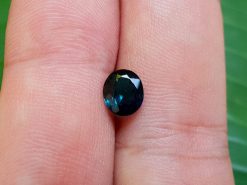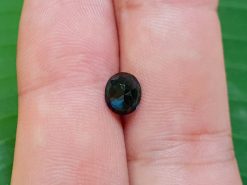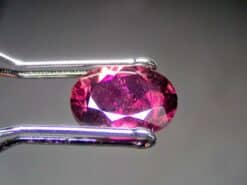Cat’s eye tourmaline

Tourmaline is a crystalline boron silicate mineral. Compounded with elements such as aluminium, iron, magnesium, sodium, lithium, or potassium.
Buy natural tourmaline in our gem shop
Cat’s eye tourmaline meaning
A semi-precious stone. Likewise other gemstones families, tourmaline also comes in a wide variety of colors.
Tourmaline is also a six-member ring cyclosilicate having a trigonal crystal system. It occurs as long, slender to thick prismatic and columnar crystals that are usually triangular in cross-section, often with curved striated faces. Furthermore, the style of termination at the ends of crystals is sometimes asymmetrical, called hemimorphism.
Furthermore, small slender prismatic crystals are common in a fine graine of granite. It si called aplite, and it’s often forming radial daisy-like patterns. Tourmaline has three sides prisms, no other common mineral has three sides. Prisms faces often have heavy vertical striations that produce a rounded triangular effect.
Finally, tourmaline is rarely perfectly euhedral. An exception was the fine dravite tourmalines of Yinnietharra, in western Australia. All hemimorphic crystals are piezoelectric, and are often pyroelectric as well.
Cat’s eye tourmaline stone effect
In gemology, chatoyancy, chatoyance or cat’s eye effect, is an optical reflectance effect seen in certain gemstones. Coined from the French “oeil de chat”, meaning “cat’s eye”, chatoyancy arises either from the fibrous structure of a material, as in cat’s eye tourmaline, or from fibrous inclusions or cavities within the stone, as in cat’s eye chrysoberyl.
The precipitates that cause chatoyance in chrysoberyl are the mineral rutile, composed mostly of titanium dioxide. Examined samples have yielded no evidence of tubes or fibers.The needles precipitates all align perpendicularly with respect to cat’s eye effect. The lattice parameter of the needles matches only one of the three orthorhombic crystal axes of the chrysoberyl, as a result of an alignment along that direction.
The phenomenon resembles the brilliance of a silk spool. The luminous streak of reflected light is always perpendicular to the direction of the fibres. For a gemstone to show this effect best it must be cut en cabochon, rounded with a flat base rather than faceted, with the fibers or fibrous structures parallel to the base of the finished gem.
The best finished specimens show a single sharply defined band of light that moves across the stone when it is rotated. Chatoyant stones of lesser quality display a banded effect as is typical with cat’s-eye varieties of quartz. Faceted stones do not show the effect well.
Cat’s eye tourmaline price per carat
While less expensive than top quality Brazilian paraiba, some Mozambique material sells for well over $5,000 per carat, which still is extremely high compared to other tourmalines.
Cat’s eye tourmaline benefits
Cat’s eye tourmaline gemstone brings discipline and self association in one’s life. It can attract sudden wealth, as it is associated with Ketu. The crystal has magical properties to heal negative thoughts and enhance wisdom and intellect.
Cat’s eye tourmaline from Brazil
Natural tourmaline for sale in our gem shop
We make custom made tourmaline jewelry as engagement rings, necklaces, stud earrings, bracelets, pendants… Please contact us for a quote.
















